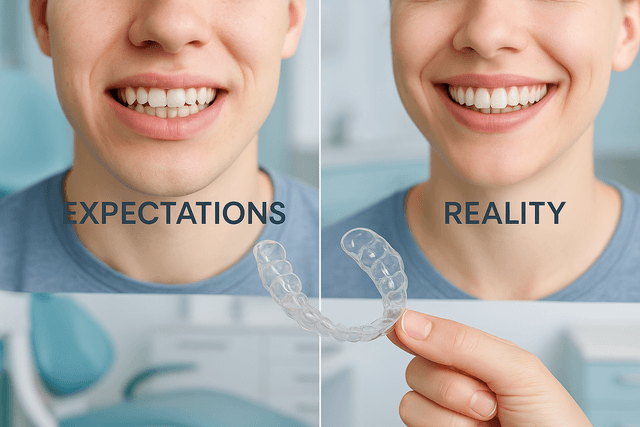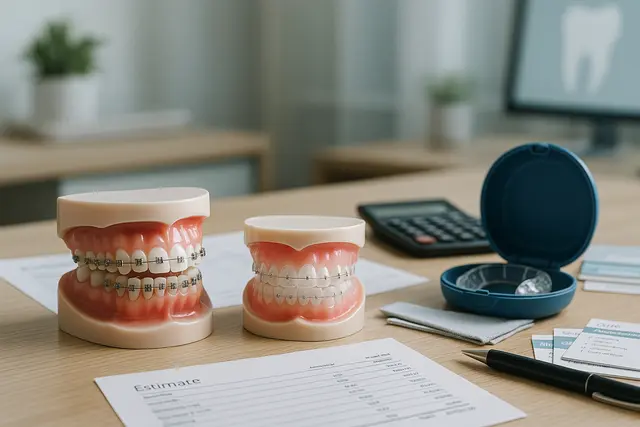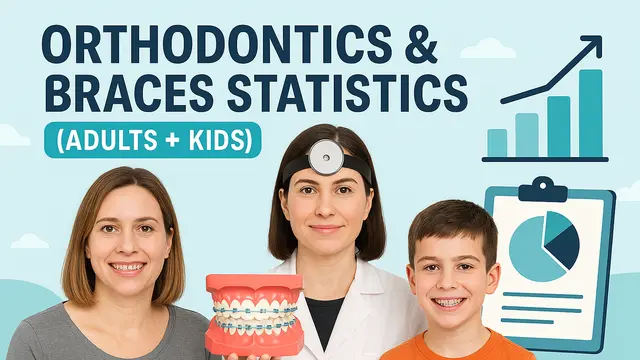Orthodontics
5 min read
Jul 07, 2025
Before and After Teeth Aligners Guide: Expectations vs. Reality
Thinking about getting teeth aligners but not sure what to really expect? You’re not alone. From those flawless before-and-after shots to the promise of a straighter smile without metal braces, aligners can seem like magic. But what’s hype, and what’s real?

So, you’re thinking about aligners. You want straighter teeth, but without the throwback look of metal braces. Maybe you’ve seen a friend’s Invisalign aligners results and thought, “I want that new smile too.” You’re not alone.
Clear aligners are everywhere now, from dentist offices to ads between your favorite shows. But what really happens after months of wearing aligners? Let’s break down the expectations, the reality, and everything in between, without the sugarcoating.
Aligners to Gradually Straighten Your Teeth: What You Expect vs. What Happens
You expect aligners to gently nudge your teeth into picture-perfect rows, like a soft push from a friend who wants you to sit straighter. That part is actually true. Aligners can help move your teeth using precise, custom-made trays, each one shifting things a bit more until your teeth look like they’ve had a glow-up.
But here’s the reality check: this isn’t an overnight transformation. Aligners work best on mild to moderate crowded teeth, overbites, or spacing issues like gap teeth. And they only work if you wear them. Like, really wear them. You’ll need to keep them in for about 22 hours a day.
That means meals, coffee breaks, and mid-afternoon snacks all come with the minor hassle of removing and rinsing. If that sounds annoying, yep, it can be. But if you follow the treatment plan, the payoff is worth it.
Invisalign® vs. Traditional Metal Braces: Is It Really That Different?
Let’s be honest: traditional metal braces get the job done. But they’re not exactly subtle. Clear aligners, especially Invisalign aligners, are marketed as the modern, discreet and comfortable alternative to traditional metal braces. And in many ways, they are. No wires. No brackets. No emergency orthodontist visits because a wire popped loose during pizza night.
Still, “invisible” doesn’t mean invisible. You’ll notice them. Other people might too, especially in up-close conversations. But most folks will just think you’re super committed to your oral hygiene. And unlike braces, you can pop them out for date nights or important meetings (just don’t forget to put them back in).
Clear Aligners and Crowded Teeth: Can They Handle It?
Got crowded teeth? You’re not alone. It’s one of the most common reasons people seek orthodontic treatment. Aligners are surprisingly good at tackling mild to moderate crowding, especially in the upper and lower front teeth. If your crowding is severe or involves tooth rotation, though, your dentist or orthodontist might recommend attachments or even combine Invisalign treatment with other orthodontic tools.
Keep in mind that aligners to ensure proper movement must fit snugly. Your clear aligner trays will hug every bump and curve of your teeth, working behind the scenes to gently straighten them. And when they work? Wow. You’ll barely recognize your incisor in those before and after photos.
Straightening Teeth with Aligners: Beyond the Perfect Smile
Let’s talk motivation. Sure, we all want that perfect smile. But teeth straightening isn’t just about looks. Crooked teeth can make brushing harder, leading to poor oral hygiene and higher risks of gum issues. Straight teeth aren’t just pretty, they’re practical. They’re easier to clean, and they help your bite line up properly, reducing stress on your jaw.
Aligners can gradually straighten her teeth, his teeth, your teeth, it’s universal. And they can improve her smile or yours without turning your whole mouth into a metal jungle.
Deep Bite? Overjet? Overbite? What Aligners Can (and Can’t) Fix
Clear aligner treatment can handle more than just a little twist or tilt. Issues like a deep bite or mild overjet and overbite often respond well to Invisalign treatment. Overbites too, especially when caught early. Aligners use gentle, constant pressure to shift both the front teeth and the back ones, rebalancing your bite.
But some cases need more than aligners alone. That’s why a good treatment plan starts with a thorough dental assessment. A great dentist or orthodontist will know when to suggest aligners, and when to recommend another route.
What Happens to Your Teeth with Invisalign: The Middle of the Journey
By month two, you might start to see changes. Your front teeth will shift first, especially if those were the most crowded. Your aligners might start to feel loose just before it’s time to switch to the next set, don’t panic, that’s a sign they’re working. Some patients notice tenderness. Some feel nothing at all.
Remember: the teeth will gradually move, not dramatically snap into place. And that’s a good thing. Fast movement can be harmful. Aligners take a gentle approach, which protects your gums, your roots, and your peace of mind.
Teeth Whitening After Aligners: Your Bonus Round
Once you’ve achieved the smile you’ve always wanted, it’s tempting to chase that sparkle. Many people opt for teeth whitening right after aligner treatment. It’s like the final polish on a sculpture. Just wait until your orthodontist gives the green light. Some whitening treatments can be harsh on freshly shifted teeth or sensitive gums.
Patient Results and Clear Teeth Aligners: Managing Real-Life Expectations
Let’s talk real talk. You’ve seen those before and after photos. The dramatic “wow” moments. And while clear teeth aligners can deliver stunning transformations, not everyone ends up with Hollywood teeth, and that’s okay.
Some folks will need longer treatment times
Some will need refinements (bonus trays at the end)
Some results are more subtle, but still confidence-boosting
We’ve seen patients go from hesitant half-smiles to flashing a confident smile in every selfie. The power of clear aligners isn’t just in straight teeth, it’s in how you feel showing them off.
Custom-Made Invisalign Aligners: Why the Fit Matters
Every Invisalign aligner is made just for your mouth. That’s no exaggeration. Your digital scans get used to shape trays that match your dental anatomy down to the micrometer. This snug fit is key to effective tooth movement, and to comfort. If your trays hurt too much or feel weirdly loose, it’s time to talk to your provider.
Ready to Transform Your Smile? Here's What to Know Before You Begin
If you’re interested in Invisalign or alignerco clear aligners or any of the other options out there, start by asking the right questions. How long will your treatment time be? Will it fix your overbite or crowded teeth? What happens if your aligners crack during your third week on vacation?
And always choose a licensed dentist or orthodontist to oversee your treatment. This isn’t the place to cut corners. A personalized treatment option that’s monitored regularly is what separates great results from frustrating experiences.
Final Thoughts
Aligners won’t change your life overnight, but they can transform your smile. With clear aligners, a bit of patience, and a few sacrifices (RIP to spontaneous snacks), you can absolutely achieve the smile of your dreams. Just go in with eyes wide open, wear your aligners as directed, and keep that confident smile in sight. The glow-up is coming.
How Long Do I Need to Wear My Aligners Each Day?
For best results, aligners must be worn 20 to 22 hours a day. That means removing them only for eating, drinking (anything other than water), brushing, and flossing. Skipping hours can delay progress and may require treatment refinements.
Can Clear Aligners Fix Crowded or Crooked Teeth?
Yes, clear aligners are effective for mild to moderate crowding and misalignment. They use gentle, consistent pressure to reposition teeth over time. Severe cases might need extra attachments or a combination of treatments for the best results.
What Should I Expect During the Middle of Invisalign Treatment?
By the second month, you may see visible progress, especially in the front teeth. Some aligners may feel loose near the end of each wear cycle, which is normal. Tenderness is common but typically mild, and a sign your teeth are shifting as planned.
Is Teeth Whitening Safe After Invisalign Treatment?
Yes, whitening is safe after aligner treatment, but timing matters. Wait until your dentist or orthodontist confirms your teeth and gums have settled. Whitening too soon can cause sensitivity, especially if your teeth were recently moved.
Read Next
Related Posts

Orthodontics
Retainer That Looks like Braces: Benefits for Long-Term Alignment
A retainer might not get as much attention as braces, but it plays a crucial role in maintaining your smile after orthodontic treatment. Whether you're new to retainers or curious about the type that looks like braces, understanding their purpose and benefits is key to keeping your teeth aligned for the long haul.
6 min read
Sep 15, 2025

Orthodontics
How Much Are Metal Braces? Cost Comparison With Other Options
Thinking about getting braces but overwhelmed by the cost? You’re not alone. Orthodontic treatment can be a major investment, and understanding the different price points, from metal braces to clear aligners, can help you make a smart, confident decision.
5 min read
Sep 15, 2025

Orthodontics
Orthodontics & Braces Statistics (Adults + Kids)
Orthodontics has transformed from a niche medical service for teenagers into a booming sector that spans all ages. Today, both adults and children seek orthodontic treatment to improve their smiles, fix bite issues, and boost self-confidence.
4 min read
Aug 21, 2025
Don’t have time to research every dentist around you?
See why 30k+ patients trusted us